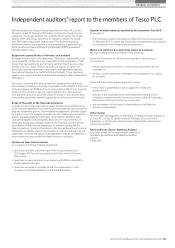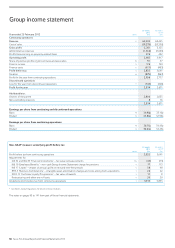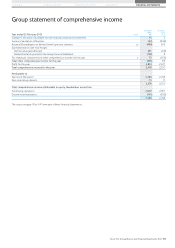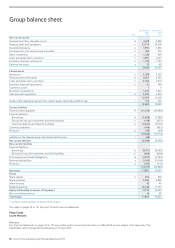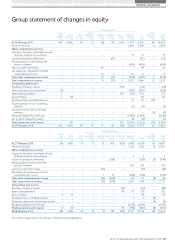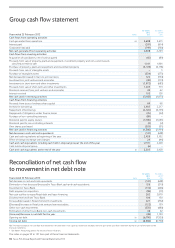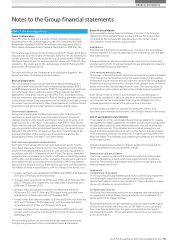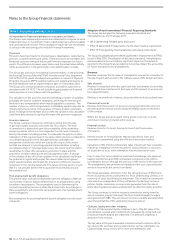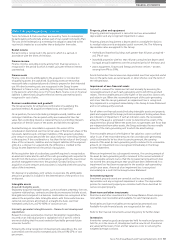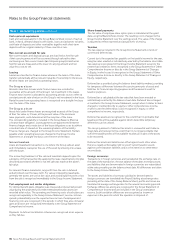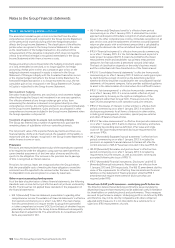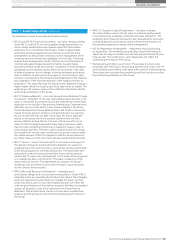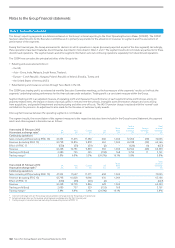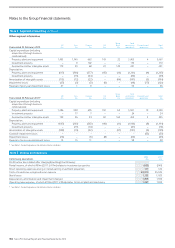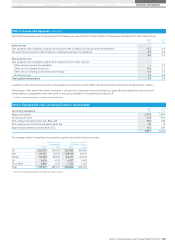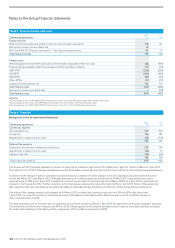Tesco 2012 Annual Report Download - page 101
Download and view the complete annual report
Please find page 101 of the 2012 Tesco annual report below. You can navigate through the pages in the report by either clicking on the pages listed below, or by using the keyword search tool below to find specific information within the annual report.
STRATEGIC REVIEW PERFORMANCE REVIEW GOVERNANCE FINANCIAL STATEMENTS
OVERVIEW
Tesco for Schools & Clubs vouchers are issued by Tesco for redemption
by participating schools/clubs and are part of our overall Community Plan.
The cost of the redemption (i.e meeting the obligation attached to the
vouchers) is treated as a cost rather than a deduction from sales.
Rental income
Rental income is recognised in the period in which it is earned, in
accordance with the terms of the lease.
Finance income
Finance income, excluding income arising from financial services, is
recognised in the period to which it relates using the effective interest
ratemethod.
Finance costs
Finance costs directly attributable to the acquisition or construction
of qualifying assets are capitalised. Qualifying assets are those that
necessarily take a substantial period of time to prepare for their intended
use. All other borrowing costs are recognised in the Group Income
Statement in finance costs, excluding those arising from financial services,
in the period in which they occur. For Tesco Bank, finance cost on financial
liabilities is determined using the effective interest rate method and is
recognised in cost of sales.
Business combinations and goodwill
The Group accounts for all business combinations by applying the
purchase method. All acquisition-related costs are expensed.
On acquisition, the assets (including intangible assets), liabilities and
contingent liabilities of an acquired entity are measured at their fair
value. Non-controlling interest is stated at the non-controlling interest’s
proportion of the fair values of the assets and liabilities recognised.
Goodwill arising on consolidation represents the excess of the
consideration transferred over the net fair value of the Group’s share of the
net assets, liabilities and contingent liabilities of the acquired subsidiary,
joint venture or associate and the fair value of the non-controlling interest
in the acquiree. If the consideration is less than the fair value of the Group’s
share of the net assets, liabilities and contingent liabilities of the acquired
entity (i.e. a discount on acquisition), the difference is credited to the
Group Income Statement in the period of acquisition.
At the acquisition date of a subsidiary, goodwill acquired is recognised as
an asset and is allocated to each of the cash-generating units expected to
benefit from the business combination’s synergies and to the lowest level
at which management monitors the goodwill. Goodwill arising on the
acquisition of joint ventures and associates is included within the carrying
value of the investment.
On disposal of a subsidiary, joint venture or associate, the attributable
amount of goodwill is included in the determination of the profit or loss
ondisposal.
Intangible assets
Acquired intangible assets
Separately acquired intangible assets, such as software, pharmacy licences,
customer relationships, contracts and brands are measured initially at cost.
Intangible assets acquired in a business combination are recognised at fair
value at the acquisition date. Intangible assets with finite useful lives are
carried at cost and are amortised on a straight-line basis over their
estimated useful lives, at 2%-100% of cost per annum.
Internally-generated intangible assets – Research and development
expenditure
Research costs are expensed as incurred. Development expenditure
incurred on an individual project is capitalised only if specific criteria
are met including that the asset created will probably generate future
economic benefits.
Following the initial recognition of development expenditure, the cost
isamortised over the asset’s estimated useful life at 10%-25% of cost
perannum.
Property, plant and equipment
Property, plant and equipment is carried at cost less accumulated
depreciation and any recognised impairment in value.
Property, plant and equipment is depreciated on a straight-line basis to
its residual value over its anticipated useful economic life. The following
depreciation rates are applied for the Group:
freehold and leasehold buildings with greater than 40 years unexpired –
at 2.5% of cost;
leasehold properties with less than 40 years unexpired are depreciated
by equal annual instalments over the unexpired period of the lease; and
plant, equipment, fixtures and fittings and motor vehicles – at rates
varying from 9% to 50%.
Assets held under finance leases are depreciated over their expected useful
lives on the same basis as owned assets or, when shorter, over the term of
the relevant lease.
Impairment of non-financial assets
Goodwill is reviewed for impairment at least annually by assessing the
recoverable amount of each cash-generating unit to which the goodwill
relates. The recoverable amount is the higher of fair value less costs to sell,
and value in use. When the recoverable amount of the cash-generating
unit is less than the carrying amount, an impairment loss is recognised.
Any impairment is recognised immediately in the Group Income Statement
and is not subsequently reversed.
For all other non-financial assets (including intangible assets and property,
plant and equipment) the Group performs impairment testing where there
are indicators of impairment. If such an indicator exists, the recoverable
amount of the asset is estimated in order to determine the extent of the
impairment loss (if any). Where the asset does not generate cash flows that
are independent from other assets, the Group estimates the recoverable
amount of the cash-generating unit to which the asset belongs.
The recoverable amount is the higher of fair value less costs to sell and
value in use. If the recoverable amount of an asset (or cash-generating
unit) is estimated to be less than its carrying amount, the carrying
amountof the asset (or cash-generating unit) is reduced to its recoverable
amount. An impairment loss is recognised immediately in the Group
Income Statement.
Where an impairment loss subsequently reverses, the carrying amount of
the asset (or cash-generating unit) is increased to the revised estimate of
the recoverable amount, but so that the increased carrying amount does
not exceed the carrying amount that would have been determined if no
impairment loss had been recognised for the asset (or cash-generating
unit) in prior years. A reversal of an impairment loss is recognised
immediately as a credit to the Group Income Statement.
Investment property
Investment property assets are carried at cost less accumulated
depreciation and any recognised impairment in value. The depreciation
policies for investment property are consistent with those described for
owner-occupied property.
Short-term and other investments
Short-term and other investments in the Group Balance Sheet comprise
receivables, loan receivables and available-for-sale financial assets.
Receivables and loan receivables are recognised at amortised cost.
Available-for-sale financial assets are recognised at fair value.
Refer to the financial instruments accounting policy for further detail.
Inventories
Inventories comprise goods and properties held for resale and properties
held for, or in the course of, development with a view to sell. Inventories
arevalued at the lower of cost and fair value less costs to sell using the
weighted average cost basis.
Note 1 Accounting policies continued
Tesco PLC Annual Report and Financial Statements 2012 97




